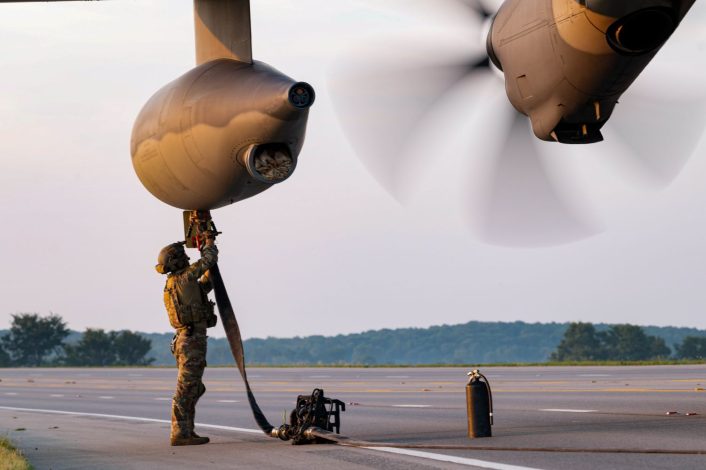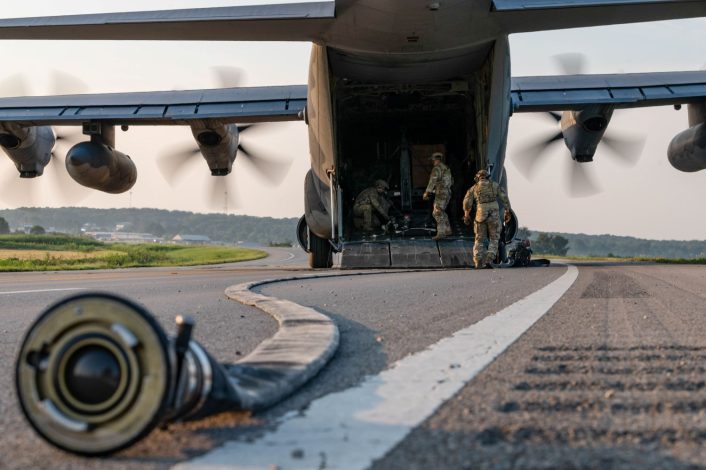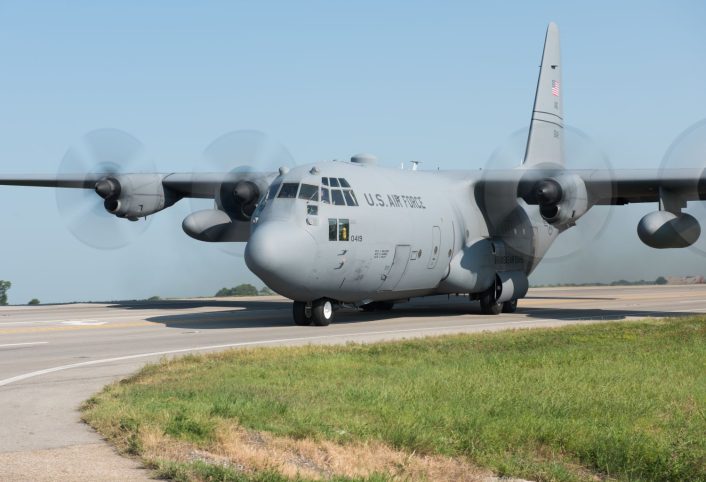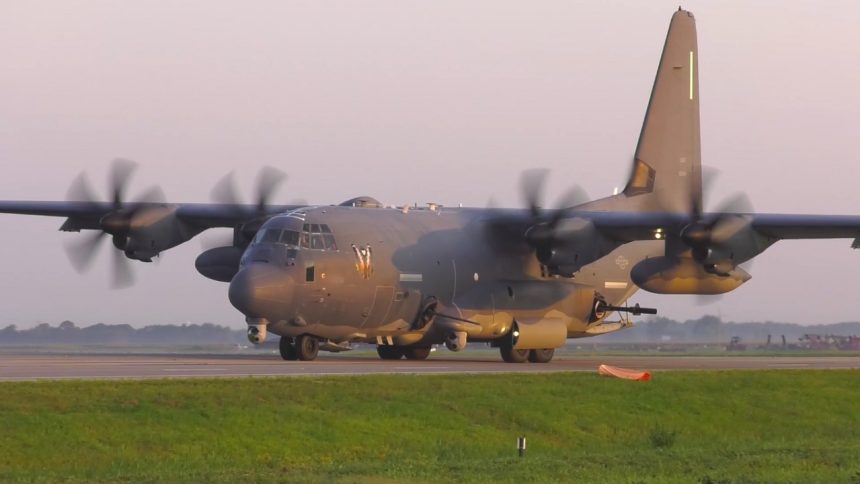AFSOC’s MC-130J, AC-130J, and C-146A try their hands at operating in austere, contested environments, such as a highway used as an improvised runway.
On August 4, 2024, the U.S. Air Force Special Operations Command’s 1st and 492nd Special Operations Wings carried out an Agile Combat Employment (ACE) in rural Bono, Arkansas. The aircraft were participating in the Emerald Warrior 24 exercise. Emerald Warrior is described as being a “joint, combined exercise that provides realistic and relevant, high-end training to prepare special operations forces, conventional forces, and international partners in an evolving strategic environment.”
The exercise began on Arkansas’ Highway 63 with Special Tactics airmen securing the area. Once secured, a Dornier C-146A Wolfhound and Lockheed Martin MC-130J Commando II of Hurlburt Field’s 492nd Special Operations Wing touched down. The MC-130J was used to deliver Forward Area Refueling Point (FARP) equipment and personnel to later refuel an AC-130J Ghostrider of the 1st Special Operations Wing. The AC-130J landed, refueled, rearmed, and departed the area, accomplishing the ACE’s objective.
The C-146A, the Dornier 328-based airplane usually staying under the radar in Air Force circles, was used to transport the Special Tactics team to and from the area. As reported by The Aviationist, the type also participated in some highway operations exercises in Latvia in 2022.

Agile Combat Employments are, according to the official U.S. Air Force Doctrine Note 1-21, “a proactive and reactive operational scheme of maneuver executed within threat timelines to increase survivability while generating combat power”. In other words, an ACE tests a unit’s ability to operate and excel out of an unfamiliar airfield (or, in this case, a highway).
“Emerald Warrior FTX II demonstrates to our adversaries that we can meet them anytime, any place, anywhere, without the need for traditional runways to project air power,” said Col. Patrick Dierig, 1 SOW commander. “By landing an AC-130J on a highway and conducting FARP, we’re proving our ability to operate in austere and unique environments. It shows our commitment to maintain operational flexibility and readiness, ensuring we can deliver decisive airpower whenever and wherever it’s needed.”
In support of the exercise, the Wing utilized Forward Area Refueling Point (FARP), a procedure that involves specialized Petroleum, Oils, and Lubricants (POL) airmen offloading fuel to bladders or directly to other aircraft from a “tanker” that flies fuel into an isolated area. The “tanker” – actually a cargo aircraft like the C-17 or C-130 – carries the Aerial Bulk Fuel Delivery System (ABFDS) to accomplish the mission. FARP itself is very selective with less than 100 airmen Air Force-wide that even requires tryouts.

Landing on highways is nothing new for the U.S. Air Force, but this exercise is significant because of the scale of the ACE and because it was the first time the AC-130J landed on a highway. Notably, A-10s of the Michigan Air National Guard also landed on American highways in Michigan during Northern Agility 22-1 in 2022 and, before that, as part of Northern Strike 21.
Highway landings are also a popular exercise objective in Europe, with recent exercises including Switzerland, Norway, and Poland. The Arkansas Air National Guard’s 189th Airlift Wing also took the opportunity to operate on the highway with their C-130H Hercules airlifters.

The AC-130J Ghostrider – The Latest Edition of the World-Renowned Gunship
The AC-130J, flying since replacing the AC-130H Spectre in 2017, has been in the news quite a bit lately. In late June, 2024, the airframe trained with launching AGM-114 Hellfire missiles and dropping GBU-39 small-diameter bombs (SDBs) in an exercise in South Korea. Just last week, a Ghostrider again made headlines when one was used to help sink the retired USS Tarawa (LHA-1) and the USS Dubuque (LPD-8) in the U.S. Navy’s RIMPAC (Rim of the Pacific) exercise.
The AC-130J finds itself in a similar position to the A-10C – an airplane specialized in close air support and counter-insurgency that needs to adapt to the “near peer” fight. The current AC-130J Ghostrider is a defined as 5th generation gunship, which has replaced the AC-130W, AC-130U and AC-130H.
The highly modified variant of the C-130J aircraft features advanced technologies and capabilities tailored for special operations missions. Notable enhancements include a modern two-pilot flight station with fully integrated digital avionics, dual inertial navigation systems coupled with GPS, and the Precision Strike Package.
This package incorporates a mission management console, robust communications suite, two electro-optical/infrared sensors, advanced fire control equipment, and the ability to deliver precision-guided munitions. The mission management system seamlessly integrates sensor, communication, environmental, order of battle, and threat information to provide a comprehensive operational picture.
The AC-130J is the most heavily-armed gunship in history, equipped with a variety of potent weaponry, including a trainable 30mm GAU-23/A cannon and 105mm cannon along with hardpoints on its wings for eight GBU-39s or AGM-114 Hellfire missiles.
This diverse array of weapons allows the AC-130J to engage targets with precision and effectiveness, especially in low-light or adverse weather conditions. Overall, it can play a critical role in supporting ground operations, providing close air support to troops in contact, conducting armed reconnaissance missions, and engaging enemy targets.
The AC-130J gunship employs a unique tactical approach when using its cannons: the aircraft circles over a target area in a constant left turn and uses its side-firing cannons to engage ground targets effectively. This allows the gunship to maintain a consistent orbit path around the target while employing its cannons to deliver accurate and sustained fire.
The AC-130’s sophisticated sensors and targeting systems enable precise targeting: the crew aboard the gunship coordinates to adjust the aircraft’s flight path and firing angles, ensuring that the cannons are effectively directed towards the intended targets on the ground.









